Dawoodi Bohra

Isma‘ilism |
|---|
 |
|
Branches / sects
States / region People
Others |
|
|
|
|
The Dawoodi Bohras are a sect within the Ismā'īlī branch of Shia Islam.[1][2] The largest populations of Dawoodi Bohras reside in India, Pakistan, Yemen and East Africa. There are also significant numbers living in Europe, North America, South East Asia and Australia. Most sources put the worldwide population to be one million.[3]
The Dawoodi Bohra follow a sort of Shia Islam as propagated by the Fatimid Imamate in medieval Egypt. They pray three times a day, joining both afternoon prayers Zuhr and Asr, and both evening prayers Maghreb and Isha. They fast in the month of Ramadan, perform Haj and Umrah and give Zakat. The Dawoodi Bohras, being Ismailis and thus Jafaris, were included as Muslims in the Amman Message.[4] There are some criticisms of the Amman message.[5]
In all matters of prayer, dress, physical comportment and even avoidance of financial interest, they are highly conservative. At the same time, they eagerly adopt any and every aspect of modern or Western culture that is not specifically forbidden. Far from displaying the anti-Western attitudes sometimes found among other revivalist groups, Bohras proudly send their children to Britain or the United States for education, exhibit greater gender equality than most communities of the subcontinent and have become Internet pioneers uniting members of their far flung denomination into a worldwide cyber congregation. [3]
History
Dawoodi Bohras are a subset Islam. They are traced as: Dawoodi, Taiyebi, Musta'li, Isma'ili, Shia, Muslims.[6]:1–4[7]
Evolution of Dawoodi Bohra from other Shia sects
The Dawoodi Bohra sect is a Shia sect also referred to as the Tayyabī Musta'lī Ismā'īlī sect. The Isma'ilis were split from the now mainstream Ithna Ashari Shias over the succession issue of Imam Jafar Al-Sadiq. The Isma'ilis took Isma'il bin Jafar as their Imam whereas the Twelvers (Ithna Ashari Shia) took Musa Kazim bin Jafar Al-Sadiq as their Imam. The Ismailis split into Druze and mainstream Isma'ilis due to a succession issue and further down the line they again split into Nizari and Musta'ali branches. Bohra evaluated in India had link to Fatimid through Yemeni Queen Arwa from the time of Imam Mustansir era. The Musta'ali branch to which Dawoodi Bohra trace their legacy continued until the 21st Imam Al-Tayyab, who went into occultation (hiding). His direct descendant is considered as the current Imam and remains in seclusion. While the Imam is in seclusion, the governance of the sect has been entrusted to the Da'i al-Mutlaq (Vicegerent /Unrestricted Missionary). Splinter groups of the Bohras have subsequently emerged over the succession dispute of the preceding Da'i.
Dawoodi Bohra and the Fatimid dynasty
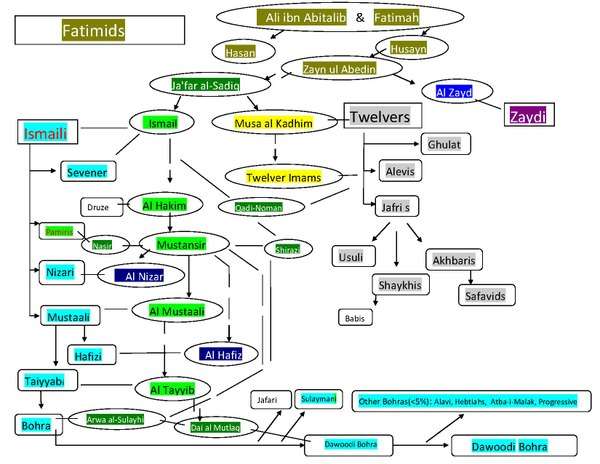
The first through the fifth Ismāʿīlī Imams - until Ja'far al-Sadiq - are commonly accepted by all the Shi'a, although numbered differently. Bohras and Nizari Ismāʿīlīs treat Ali as Vasi (successor to Mohammad) and Imam Hasan as first Imam whereas Twelvers number Ali as the first. The followers of Ja'far's son, Isma'il ibn Jafar, became Ismailis, to whom the Bohras belong. Twelvers believe that Musa al-Kadhim was heir to Ja'far instead; their Imams diverged at that point.
During the period of Ja'far, the Abbasid Caliphate replaced the Umayyads and began to aggressively oppose belief in an Imamate. Due to strong suppression by the Abbasids, the seventh Ismāʿīlī Imam, Muhammad ibn Ismail, went into a period of Occultation. During this period his representative, the Dāʿī, maintained the community.
The names of the eighth, ninth, and tenth Imams are considered by some traditions to be "hidden", known only by their nicknames due to threats from the Abbasids. However, the Dawoodi Bohra, claim to have the true names of all the known Imams in sequence, including the "hidden" Imams, namely: the eighth Ahmad al-Wafi (Abadullah), the ninth Muhammad at-Taqi (Ahmed ibn Abadullah), and the tenth, Rabi Abdullah (Husain ibn Ahmed).[8]
The 11th Imam, Abdullah al-Mahdi Billah, founded the Fatimid Caliphate in 909 CE in Ifriqiya (present Tunisia), ending the occultation. In Ismāʿīlī eyes this act again united the Imamate and the Caliphate in one person. The Fatimids then extended up to the central Maghreb (now Morocco, Algeria, Libya). They entered and conquered Egypt in 969 CE during the reign of the fourteenth Imam, al-Mu'izz li-Din Allah, and made Cairo their capital. After the eighteenth Imam, al-Mustansir Billah, the Nizari sect believed that his son Nizar was his successor, while another Ismāʿīlī branch known as the Mustaali (from whom the Dawoodi Bohra would eventually form), supported his other son, al-Musta'li. The Fatimid dynasty continued with al-Musta'li as both Imam and Caliph, and that joint position held until the 20th Imam, al-Amir bi-Ahkami l-Lah (1132 CE).
Tayyibi-Hafizi schism
At the death of Imam Amir, one branch of the Mustaali faith claimed that he had transferred the imamate to his son at-Tayyib Abi l-Qasim, who was then two years old. Another faction claimed Amir died without producing an heir, and supported Amir's cousin al-Hafiz as both the rightful Caliph and Imam. The al-Hafiz faction became the Hafizi Ismailis, who later converted during the rule of Sultan Ṣalāḥ ad-Dīn Yūsuf ibn Ayyūbi. The supporters of Tayyeb became the Tayyibi Ismāʿīlī.
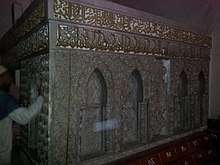
Tayyeb's claim to the imamate was endorsed by the Hurrah al-Malika ("the Noble Queen") Arwa al-Sulayhi, the Queen of Yemen. Arwa was designated a hujjah, the highest rank in the Yemeni Dawat, by al-Mustansir in 1084 CE. Under Queen Arwa, the Dai al-Balagh (intermediary between the Imam in Cairo and local headquarters) Lamak ibn Malik and then Yahya ibn Lamak worked for the cause of the Fatimids.
Tayyibis (which include the modern Dawoodi Bohra) believe the second and current period of satr began after Imam Tayyeb went into seclusion, and Queen Arwa created the office of the Dai al-Mutlaq to administer the community in the Imam's absence. Zoeb bin Moosa (d.546 AH/1151 CE) was the first Dai-ul-Mutlaq, and lived and died in Haus, Yemen. His ma'dhūn was Syedna Khattab bin Hasan. The 3rd Dai Sayedna Hatim (d. 1191 CE) was prominent among the Du'at of Yemen and wrote many books, both exoteric and esoteric in philosophy on the Ismaili sect.
Transfer of Dawat to India
Moulai Abdullah was the first Walī al-Hind in the era of Imam Mustansir (427–487 AH). Moulai Abdullah and Moulai Nuruddin were originally from Gujarat and went to Cairo, Egypt, to learn. They came to India in 467 AH as missionaries of the Imam. Moulai Ahmed was also their companion.
Dā'ī Zoeb appointed Maulai Yaqoob (after the death of Maulai Abdullah), who was the second Walī al-Hind of the Fatimid dawat. Moulai Yaqoob was the first person of Indian origin to receive this honour under the Dā'ī. He was the son of Moulai Bharmal, minister of Hindu Solanki King Siddhraja Jaya Singha (Anhalwara, Patan). With Minister Moulai Tarmal, they had honoured the Fatimid dawat along with their fellow citizens on the call of Moulai Abdullah. Moulai Fakhruddin, son of Moulai Tarmal, was sent to western Rajasthan, India, and syedi Nuruddin went to the Deccan (death: Jumadi al-Ula 11 at Don Gaum, Aurangabad, Maharashtra, India).
One Dā'ī after another continued until the 23rd Dā'ī in Yemen whilst in India the Waliship continued in the descendants of Moulai Yaqoob; Moulai Ishaq, Moulai Ali, Moulai Hasan Fir. Moulai Hasan Fir was the fifth Wali in the era of the 16th Dai Syedna Abdullah (d.809 AH/1406 CE) of Yemen. The Awliya al-Hind were champions of the Fatimid dawat in India, and were instrumental in maintaining & propagating it on instructions of the Dā'ī at Yemen, and it is because of them that the Fatimid dawat was able to survive the persecutions of Cairo and Yemen.
The wali Moulai Jafer, Moulai Abdul Wahab, Moulai Qasim Khan bin Hasan (d.950AH, Ahmedabad) and last Jalal Shamshuddin bin Hasan (1567 CE) (12th wali-ul Hind and also became 25th Dai) were of great help in the era of the 21st to 24th Dai. It was during this time when the Dawat was transferred to India from Yemen, that the 23rd Dai-al-Mutlaq, Mohammed Ezzuddin, performed nass (transfer of authority) on Yusuf Najmuddin ibn Sulaiman of Sidhpur, Gujrat, India.
The 24th Dai, Yusuf Najmuddin bin Sulayman (d.1567 CE), shifted the whole administration of the Dawat (mission) to India, in part due to their persecution by the Zaydi Imams. However, Yusuf Najmuddin continued to live in Yemen and died there. The last Wali-ul-Hind and 25th Dai Jalal Shamshuddin bin Hasan (d.1567 CE) was the first Dai to die in India; his mausoleum is in Ahmedabad, India. Dai Jalal's tenure as Dai was very short, only a few months, however, before his nass, he was Wali-ul Hind (after Moulai Qasim) for about 20 years under the 24th Dai Syedna Yusuf while the Dai was in Yemen.
Intra-Bohra schisms
Following the death of the 26th Dai in 1591 CE, Suleman bin Hasan, the grandson of the 24th Dai, was wali in Yemen and claimed the succession, supported by a few Bohras from Yemen and India. However, most Bohras denied his claim of nass, declaring that the supporting documentary evidence was forged. The case was put up in the royal court of Mughal emperor Akbar resulting in shahi farman(royal order) issued in favaour of Syedna Dawood.[9][10] The two factions separated, with the followers of Suleman Bin Hasan becoming the Sulaymanis, and the followers of Syedna Dawood Bin Qutubshah becoming the Dawoodi Bohra.
Later, in the period of the 29th Dai Abduttayyeb Zakiuddin, a small group of Aliya Bohra separated under Ali bin Ibrahim (1034 AH/1634 CE), the grandson of the 28th Da'i Syedna Sheikh Adam Safiyuddin. A further branch broke from the Dawoodi in 1754, with the Hebtiahs Bohra splicing in a dispute following the death of the 39th Dai.
A group of reformists, the Progressive Dawoodi Bohra, was formed by Asghar Ali Engineer. While they accept the religious authority and status of the Dai, these reformers call for social reforms within the Dawoodi Bohra community. Specifically, they object to the strict social control policies, as well as the amount of tithing requested by the clergy.[11] Its members have been excommunicated by the mainstream Dawoodi Bohra clergy.[12]
Move to India
The 34th Dai Syedna Ismail Badruddin I (son of Moulai Raj, 1657 CE onward) was the first Da'i of Indian Gujrati origin. He shifted the Dawat from Ahmedabad to Jamnagar.[13] During this period the Da'is also moved to Mandvi and later to Burhanpur. In the era of the 42nd Da'i Syedna Yusuf Najmuddin (1787 CE onward) the Dawat office shifted to Surat. The educational institute Al-Dars-al-Saifee (later renamed Al Jamea tus Saifiyah) was built in that era by the 43rd Dai Syedna Moulana Abdeali Saifuddin, who was an extremely renowned scholar in the literary field. During the period of the 51st Da'i Syedna Taher Saifuddin (1915-1965 CE), the Dawoodi Bohra Dawat administration has been located to Mumbai and continues there to the present day. The 51st and 52nd Da'is both had their residence at Saifee Mahal in Mumbai's Malabar Hill as does the current Dai Dr. Syedna Mufaddal Saifuddin.
Theology
Seven pillars
The Dawoodi Bohras follow the Seven pillars of Ismaili Islam in the tradition of Fatimid Dawat: Walayah (guardianship of the faith), Taharah (purity), salat (prayer), Zakat (alms-giving), Sawm (fasting), Hajj (pilgrimage to Mecca), and Jihad (struggle).
- Dawoodi Bohras believe Walayah to be the most important of the seven pillars of Islam. It is the love and devotion for God, through their Da'i, Imam, Wasi (Wali) Ali and Nabi Muhammad. There is an incident famous amongst Bohra which confirm how they mean and weigh ‘walayat’ principle. There was an order from the 19th Da'i Syedna Idris in Yemen to the 6th Wali-ul-Hind, Moulai Adam, to perform prayer behind a water-carrier called Sakka. Moulai Adam along with his associates were willing to perform prayer under Sakka, although this order was later revoked. As a result, the Da'wat was shifted to India.[14]
- Their interpretations of the pillars Sawm, Hajj, and Jihad are akin to those in other forms of Islam, but the Dawoodi forms of salat and zakat differ from other groups:
- Salat (prayer) as per tradition to be performed five time intervals specified as Fazr, Zohr, Ashr, Magrib and Ishah. Zohr and Ashr are overlapping period, as are Magrib and Ishah. Hence they are combined together and Bohra perform these five Salat in three intervals. Fazr in morning, Zohr & Ashr in the afternoon, and Maghrib and Ishah in the evening, making the prayers more convenient to perform.
- Zakat is done during the month of Ramzaan (Ramadan). This is organized and collected by central authority Dawat–e-Hadiyah from every member of the community. The family of a Bohra who refuses to pay Zakat is refused all religious services.[15]:200[12]
As is the case with the majority of Shi'a Muslims, the Bohra append Aliyun waliallah to their profession of faith (kalema‐tut‐ sahadat). The Dawoodi Bohra utilise the versions of the azaan (call to prayer) and shahada common to other Mustaali, which incorporate mention of Ali.
Imams and Dais
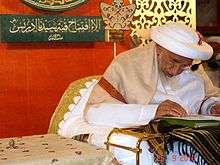
Dawoodi Bohras believe that the 21st Mustaali Imam, Taiyab abi al-Qasim, is a direct descendant of the Islamic prophet Muhammad through his daughter Fatimah. According to this belief, Ṭayyib Abī l-Qāṣim went into occultation and established the office of the Dā‘ī l-Muṭlaq as the Imām's vicegerent, with full authority to govern the believing community in all matters spiritual and temporal, as well as those of his assistants, the Ma'dhūn (Arabic: مأذون) and Mukāsir (Arabic: مكاسر). During the Imām's seclusion, a Dā‘ī l-Muṭlaq is appointed by his predecessor. The maʾzūn and mukasir are in turn appointed by the Dā‘ī l-Muṭlaq. A fundamental belief held by the Dawoodi Bohra is that the presence of the secluded Imām is guaranteed by the presence of the Dāʿī al-Muṭlaq.
During testimony of 51st Dai Syedna Taher Saifuddin, he clarified about knowledge classes of 'Zahir', 'Tavil' and, 'Hakikat' present in community. First two are known to many but third one namely 'Hakikat' content some religious truths known to very few. Some of which are known to only 2 or 3 persons in community, and there is also knowledge which is available with Dai only, and he gets it from his predecessor Dai.[16] bhai
Spiritual leader
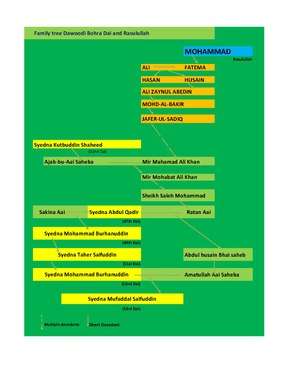

The spiritual leader of the Dawoodi Bohra community is called Da'i al-Mutlaq (Arabic: داعي المطلق), who serves as the representative of the purported hidden Imam, who according to Dawoodi Bohra's belief lives on in seclusion. The role of Da'i was created by Queen Arwa bint Ahmed (also known as Al-Hurra Al-Malika) of Yemen. It should not be confused with other offices that exist in the Imamate such as Da'i-ad-Du'at and Da'i al-Balagh. Zoeb bin Moosa was the first Da'i-al-Mutlaq.[17][18] The Current Da'i-al-Mutlaq is Dr Mufaddal Saifuddin as he was appointed as the 53rd Dai-al-Mutlaq by his father, Dr Muhammad Burhanudin on a worldwide shown live-relay.[19]
Many of Dawoodi Bohra Dais belongs to family of Moulai Fakhruddin, Hakimuddin, Khanji Pheer and, lukmanji. Many also have links with Mohammad Rasulullah family as indicated in the family trees (right).[20]
Qardhan Hasana
Islam prohibits Riba (Usury) and interest; Dawoodi Bohras follow the principle of Qardhan hasana (interest-free loans). Numerous Qardhan Hasana fund schemes have been established, many working at the local jamaat level and others working at a national level in various countries. The funds are generated from contributions of individual members but the bulk amount comes from the Da'i-al-Mutlaq. (In 2014, Mufaddal Saifuddin donated more than Rs. 103.50 crore (Rs. 1.035 billion).[21]
Mithaq
The central rite of passage for Bohras is mithaq, the only major ritual unique to the denomination. This ceremony, obligatory for every Bohra who wishes to be part of the community, is a covenant between the believer and God, effected through his wali. In addition to spelling out the duties a believer owes to Allah, it includes an oath of allegiance: a vow to accept the spiritual guidance of Syedna wholeheartedly and without reservation.
The mithaq oath is first taken at whatever age a child is deemed to have reached maturity: most commonly, thirteen years for girls, fourteen or fifteen for boys. During early puberty, a child will be brought by his or her parents for an interview with the local amil. The amil asks the youth a series of questions about the Bohra faith, and only after providing adequate answers will the child be accepted for mithaq.
On the eighteenth day of the Islamic month of zyl-Hajj, every Bohra congregation renews its mithaq vows together. The ceremony takes place on this date because (Shi’a tradition holds) it was on the eighteenth of zyl Hajj in the year 23 A.H. that the Prophet Muhammad and his son-in-law All received an oath of mithaq from 70,000 new Muslims at Ghadir Khumm on the road from Mecca to Medina. The oath is said to hearken back to a verse from the Qur’an: “God purchased from all the faithful their souls and their property in consideration of Paradise.” [22]
Calendar
The Dawoodi Bohra retain the Fatimid-era Tabular Islamic calendar,[23] which they believe matches perfectly with the lunar cycle, not requiring any correction. In this calendar, the lunar year has 354 days. Their odd-numbered months have 29 days and the even-numbered months have 30 days, except in a leap year when the 12th and final month has 30 days.[24] This is in contrast with other Muslim communities, which base the beginnings of specific Islamic months on sightings of the moon crescent.
Office and administration
The office of the Da'i al-Mutlaq, known as Dawat–e-Hadiyah, is central to secular and religious affairs among Dawoodi Bohras. The present office is in Badri Mahal, Mumbai, which is represented by Jamaat Committees in all the cities with significant numbers of Dawoodi Bohra members. The Aamil is the president of the local Jamaat committee in his respective city. He is appointed by the Dawat–e-Hadiyah, with the permission of the Dai al Mutlaq.
There are several sub committees and trusts under the Jamaat committee, looking after different aspects of Dawoodi Bohra administration.
Demographics and culture

The worldwide number of Dawoodi Bohras is estimated at just over one million.[25] The majority of adherents reside in Gujarat state in India and the city of Karachi, Pakistan. There are also significant diaspora populations in Europe, North America, the Far East and East Africa.[12]
Name and etymology
The word Bohra comes from the Gujarati word vehru ("trade"), in reference to their traditional profession.[26] The term Dawoodi comes from the support given to Dawood Bin Qutubshah during a schism that the community faced in 1592 when there was a leadership dispute.
Language
The community has a rich legacy of Arabic literature while the main spoken language is Lisan al-Dawat, a fundamentally Gujarati dialect with considerable inclusion of vocabulary from Arabic and Urdu with some English. The Script used is Perso-Arabic.
Dawoodi Bohras have a blend of ethnic cultures, including: Yemeni, Egyptian, African, Pakistani and Indian. In addition to the local languages, the Dawoodi Bohras have their own language called Lisan al-Dawat.[27] which is written in Perso-Arabic script and is derived from Arabic, Persian, Urdu and Gujarati.
Dress
When in communal attire, a Dawoodi male has a form of tunic called kurta, equally lengthy overcoat dress called saya, and an izaar typically donned underneath, all of which are mostly white, along with a white and golden cap called topi. Most men have a beard. A Bohra woman wears a two piece dress called a rida.
The Dawoodi Bohra maintain a distinct form of attire; the Dawoodi Bohra men wear a white three piece outfit, plus a white and gold cap Kufi (called a topi), and women wear the rida, a distinctive form of the commonly known burqa which is distinguished from other forms of the veil due to it sporting bright colors and decorated with patterns and lace. The ridah can have any color except black, preventing confusion of Bohra women with Sunni women and thus enabling easy identification of fellow members of the community, which in turn is important for maintaining strict social control.[12] The rida additionally differs from the burqa in that the rida does not call for covering of women's faces like the traditional veil.[28] It has a flap called the pardi that is usually folded to one side to facilitate visibility, but can also be worn over the face if so desired. (says journalist Jonah Blank).
Community centres (masjid)

Dawoodi Bohras have their own jamaats (local communities) which will be focused around a masjid or a markaz (community centre) where an "Amil" (leader appointed by the Syedna) leads namaaz and gives discourses).
Dawoodi Bohras have a unique system of communal eating with groups of 8 or 9 people seated around a thaal (particularly large metal tray). Each course of the meal is served for the people around the thaal to share. The place where meals are served is called the jamaat khaana. The Jamaat khaana is usually adjoined to the masjid complex.
In 2012, the community leadership under Mohammed Burhanuddin instituted community kitchens in Mumbai that deliver Bohra families two meals per day; the goal of this system is to free women from the task of preparing food, providing them with time to pursue education or economic activities.[29][30]
Education and educational institutes
During the 20th century, the Syednas established colleges, schools and madrasas in villages, towns and cities all around the world. The focus on literacy and education has meant that the community has a high percentage of degree holders and professionals both male and female with a high number of doctors, lawyers, architects, engineers, teachers and IT professionals in the community in addition to the large number of businessmen and industrialists.
Al Jamea tus Saifiyah is the Dawoodi Bohra theological university, which was founded in Surat, India[31] in 1814 AD(1224AH)by the 43rd Dai Moulana Abdeali Saifuddin who named it ‘Dars-e-Saifee". A second campus was founded in 1983 located in the northern foothills of Karachi, Pakistan. A third campus was established in Nairobi, Kenya in 2011, and in 2013 a fourth campus was established in Marol (Mumbai), Maharashtra.
The 51st Dai Syedna Taher Saifuddin introduced modern subjects including sciences and arts to the curriculum in 1961 and renamed the academy Al Jamea tus Saifiyah. This process of modernization continued with his son and successor Syedna Mohammad Burhanuddin who introduced 'state-of-the-art' facilities such as the Mahad al-Zahra Quran training Institute. He also made it an International Baccalaureate Office.[31] The academies are administered by a central office located in Badri Mahal, Fort, Mumbai. The 51st Da'i Syedna Taher Saifuddin was a prolific scholar who wrote more than 40 volumes or 'Risalas' and has penned more than 10,000 verses in tribute to the Shia saints. Many of his works are part of the syllabus in the different fields of Arabic study in Al Jamea tus Saifiyah.
The Aligarh Muslim University conferred a Doctorate of Theology on the 51st Da'i, Taher Saifuddin,[32] and offered him its Chancellorship.[33] He remained as Chancellor for three consecutive terms until his death in 1965.[34] In October 1999, the 52nd Dai Syedna Mohammad Burhanuddin was also elected Chancellor of the Aligarh Muslim University.[35] Mufaddal Saifuddin was elected chancellor in 2015.
Syedna Mohammad Burhanuddin established MSB Educational Institute in Nairobi and Mumbai, in 1984. Currently, there are 25 branches of the school worldwide.
Mausoleums
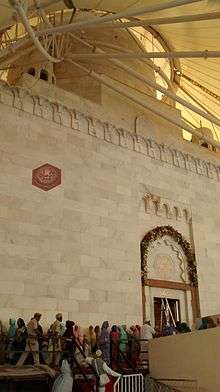
Thousands of Dawoodi Bohra visit every year mausoleums of Ahl al-Bayt especially in Medina, Karbala, Shaam and Cairo. The Dai al Mutlaq and Wali of Past have been laid to rest in rauzas, where thousands of community members visit every year, in Yemen and India. Raudat Tahera (Arabic: روضة طاهرة Rawḍatu Ṭāḥiratu), is the rauza of 51st Dai Syedna Taher Saifuddin.[36] 52nd Dai Syedna Mohammed Burhanuddin was buried by his son, Mufaddal Saifuddin in the same mausoleum.[6]:56
Hierarchy
The 52nd Dai Al Mutlaq, Dr. Syedna Mohammed Burhanuddin, served the dawat for 50 years. His main policy was one of Islamization, countering the modernizing tendencies of his predecessor[15].:184–185 Under his rule, a system of strict social control was developed using modern means of communication. A succession dispute emerged after Burhanuddin's death as his son (Mufaddal Saifuddin) and his half-brother (Khuzaima Qutbuddin) both claimed he had named them his successor.[37] The majority of the community sided with Saifuddin. Dr. Syedna Mufaddal Saifuddin, now widely recognized as the community's 53rd Dai al-Mutlaq, has continued his predecessor's social control programs. [12]
The centralized, hierarchical organization of the Dawoodi Bohras is maintained largely using persuasion and (the threat of) excommunication of those who do not conform to the rules laid down by the Syedna and other members of the clergy.[15] Excommunication dissolves marriage and bars burial in Dawoodi burial sites.[38]
Status of women
Overview
The status of women in the community underwent a major change in the latter half of the 20th century. According to Jonah Blank, they are among the best-educated women in the Indian subcontinent.[39]
Female genital mutilation
The Dawoodi Bohras practice female genital mutilation (FGM), which they call khatna.[40] There is no authoritative information about how they practice it.[41] A 1911 Bombay census of unknown reliability noted that they were performing clitorectomy.[42] Anecdotal reports in 2016–2018 suggest that the practice involves cutting or removing the tip of the clitoris or clitoral hood (Type I FGM)[40][43] or some form of symbolic nicking (Type IV).[44] As of 2017 the community was reportedly divided over the issue.[45]
United Nations bodies, including the World Health Organization, regard all forms of FGM as human-rights violations.[46] There is no reference to the practice in the Qur'an,[47] and several Islamic authorities have said that Islam does not support it.[48] Other Muslim scholars have classified it as sunnah and thus religiously virtuous.[49] Syedna Mufaddal Saifuddin is reported to have said in 2016: "The act has to happen! If it is a man, then it is right, it can be openly done, but if it is a woman then it must be done discreetly ..."[50] In 2017 a Michigan doctor and member of the Dawoodi Bohra was charged in the United States with having performed FGM on at least six girls there.[51] She denies the charge; her lawyer said she had "removed mucous membrane from the girls' genitals without cutting", before giving it to the families in a piece of gauze to be buried.[52] In 2015 three members of the Dawoodi Bohra community were convicted in Australia of charges related to performing FGM on two girls. The convictions were overturned in 2018 when the appeal court accepted that the tip of each girl's clitoris was still visible. The prosecution had alleged that the tips had been removed; the defence position was that only "symbolic khatna" had been performed.[44]
Compatibility with modern ideology
Dawoodi Bohras have tried to make their religious beliefs compatible with modern ideology, combining old practices of prayer, dress, with secular education, relative gender equality, and Internet use.[53]
Muharram and Ashura
Muharram is the first month of the Islamic calendar. The first ten days of this month are marked by Bohras to commemorate the martyrdom of Husayn ibn Ali, the grandson of Muhammad.[54]
Dawoodi Bohra begin mourning from the second eve of Muharram and continue with discourses during the day and majlises each night which climax with the day of 'Aashura' on the 10th of Muharram. This is the day on which Husain and his family and 72 of his companions and family were killed by the army of Yazid I at the Battle of Karbala on his orders. The surviving members of Husain's family and those of his followers were taken captive, marched to Damascus, and imprisoned there.
Thousands of Dawoodi Bohras flock from around the world to hear the discourses offered by the Da'i al-Mutlaq usually in a different place each year. In October 2016 the Ashara commemorations by Mufaddal Saifuddin[55] took place in Dar es Salaam, Tanzania.
The event takes place in every Bohra community worldwide along the same lines in terms of time and duration. Selected discourses by the Syedna are broadcast live from wherever he happens to be that year. It is Syedna's express instruction that Bohras set aside this time of the year to focus solely on the commemoration by taking the requisite time off from their work, businesses and institutes of education well beforehand.
Dawoodi Bohras and the world
The first Dawoodi Bohra masjid (mosque) in the West was built in Farmington Hills, Michigan in 1988. Immediately thereafter, the first Canadian masjid was inaugurated by Dr. Syedna Mohammed Burhanuddin in Toronto. Mohammed Burhanuddin inaugurated the Houston masjid in 1996, which was reconstructed into a larger masjid that is four times the size of the original. This new masjid was inaugurated in Oct, 2015 by Mufaddal Saifuddin.
In June 2001 Masjid-ul-Badri in Chicago was inaugurated. In July 2004 new mosques in New Jersey (Masjiduz-Zainy), Washington DC and Boston were inaugurated.[56] The following year, August 2005, the Dā‘ī l-Mutlaq inaugurated another new masjid in Fremont, California (metropolitan San Francisco) and was congratulated by various officials and dignitaries from local, state and federal US governments. President George W. Bush also sent a letter from the White House.[57] On 8 July 2007, Mohammad Burhanuddin inaugurated a new masjid in Paris, France.[58]
V K Singh lauds Dawoodi Bohra community's role in 'Operation Rahat' in Yemen.[59]
Cluster development project
Dawoodi Bohra plans to redevelop Mumbai’s congested Bhendi Bazaar area with about 20000 population, as per the government’s cluster development policy. Project visualized in 2009, aimed at ‘transforming’ the lives of people in 3,200 residences, 75 per cent of which were claimed to be declared dangerous for habitation. The project estimated to cost Rs. 4,000-crore and involves pulling down about 250 buildings and 1,250 shops, and building 17 towers across nine sub-clusters, a very tedious and difficult job. As the Bhendi Bazaar will go vertical, all the residents will get a minimum of 350 square feet carpet area with lots of open spaces for parks, parking and other amenities. It is referred as a 'biggest urban makeover', which will change 'the contours' of Mumbai and set an example that redevelopment is feasible of such a vast nature and capacity.[60][61][62][63]
Occasions and commemoration
| Months - شھور | Date - تأریخ | Events - واقعات |
|---|---|---|
| 1.Moharram ul-Haraam - محرم الحرام | 1 | * New Year
|
| 2 | Urs Syedi Khanji Pheer, Udaipur. | |
| 2-9 | Daily Majlis-e- Husain | |
| 10 |
| |
| 12 | Soyam Imam Husayn | |
| 13 | Birth of 20th Fatimid Imam Maulaana Aamir - 490 AH/1097 AD, Cairo | |
| 15 | Birth of 15th Fatimid Imam Maulaana Nazaar al-Azeez - 344 AH/955 AD, Cairo | |
| 16 | Urs Mubaarak of 3rd Da'i al-Mutlaq Syedna Haatim Mohiyuddin- d. 596 AH/1199 AD - Hutayb Mubaarak - Yemen | |
| 18 | Urs Mubaarak of Maulaana Ali Zayn ul-Aabedeen - d. 94 AH/712 AD - Jannat ul-Baqee' - Madinat ul Munawwarah | |
| 23 |
| |
| 27 | Urs Mubaarak of Moulai Fakhruddin - Galiyakot, Rajasthan | |
| 28 | Urs Mubaarak of Syedi Musanji bin Taaj saheb Shaheed - Vadodara, Gujarat | |
| 2. Safar ul-Muzaffar - صفر المظفر | 2 |
|
| 17 | Urs Mubaarak of 19th Fatimid Imam Maulaana Ahmad al-Musta'ali - d. 495 AH/1101 AD - al-Qaaherah al-Mo'izziyah - Cairo | |
| 18 | Urs Mubaarak of Maulaatona Sakinah, the daughter of Imam Husain | |
| 20 | Arba'een - Chehlum of Saiyed ush-Shohadaa Maulaana Imam Husain | |
| 22 | Urs Mubaarak of 8th Da'i al-Mutlaq Syedna Husain bin Saiyedna Ali - d. 667 AH/1268 AD - San'aa (Yemen) | |
| 25 | Urs Mubaarak of Khateebat-o-Karbalaa Maulaatona Zainab | |
| 27 | Urs Mubaarak of 23rd Da'i al-Mutlaq Syedna Mohammad Ezzuddin bin Saiyedna Hasan - d. 946 AH/1539 - Zabeed (Yemen) | |
| 28 | Urs Mubaarak of Maulaana Imam Hasan ibn Ali - d. 49 AH/669 AD - Jannat ul-Baqee' - Madinat ul Munawwarah | |
| 3. Rabi' ul-Awwal - ربیع الأول | 2 | Urs Mubaarak of Khaatim ul-Ambiyaa Syed ul-Awliyaa Muhammad - d. 11 AH/632 AD - Madinat ul Munawwarah and his Birth in Makkat ul Mukarramah in 1 'Aam ul-Feel[64]/570 AD |
| 3 | Birth of 16th Fatimid Imam Maulaana Husain al-Haakim - 375 AH/985 AD - al-Qaaherah al-Mo'izziyah, Cairo | |
| 12 | Mila-dun- Nabi; Urs Mubaarak of 6th Da'i al-Mutlaq Ali Bin Hanjala- d. 626 AH/1229 AD - Hamdaan (Yemen) | |
| 14 | Urs Mubaarak of Syedi Miyaji bin Taaj - Umreth, Gujarat | |
| 15 | Urs Mubaarak of 11th Fatimid Imam Maulaana Abdullaah al-Mahdi - d. 322 AH/934 AD - Mahdiyah, North Africa | |
| 16 | Urs Mubaarak 52nd Dai Syedna Mohammad Burhanuddin | |
| 17 | Birth of 5th Fatimid Imam, Maulaana Imam Abu Abdillaah Ja'far us-Saadiq - 83 AH/702 AH - Madinat ul Munawwarah | |
| 4. Rabi' ul-Aakhar - ربیع الآخر | 4 | Milaadayn Kareemayn - میلادین کریمین : Birthday - Birth of Maulaana Imam uz-Zamaan Abul Qaasim Taiyeb ul-'Asre wal Heen - 524 AH/1130 AD - al-Qaaherah al-Mo'izziyah |
| 11 | Urs Mubaarak of 14th Fatimid Imam Maulaana Ma'ad al-Mo'iz - d. 365 AH/975 AD - al-Qaaherah al-Mo'izziyah, Cairo | |
| 16 | Urs Mubaarak of 25th Da'i al-Mutlaq Syedna Jalal Shamshuddin bin Hasan - d. 975 AH/1567 AD - Ahmedabad | |
| 20 | Birth of 52nd Dai Syedna Mohammad Burhanuddin | |
| 27 | Urs Mubaarak of 26th Da'i al-Mutlaq Syedna Dawood Bin Ajabshah- d. 997 AH/1589 AD - Ahmedabad | |
| 5. Jumaadi ul-Ulaa - جمادي الأولی | 1 | Urs Mubaarak of Da'i al-Mutlaq Syedna Ahmed ibn Ali- d. 627 AH/1230 AD - Hamdaan (Yemen) |
| 10 | Urs Mubaarak of Syedato Nisaa il-Aalameen, Umm ul-A'immat il-Mayaameen, Maulaatona Faatimah az-Zahraa bint Mohammad ul-Mustafaa - d. 11 AH/632 AD - Madinat ul Munawwarah | |
| 11 | Urs Mubaarak of syedi Nuruddin- Dongaam (Aurangabad) | |
| 6. Jumaadi ul-Ukhraa - جمادي الأخری | 14 | Urs Mubaarak of Gunj Shohadaa - Ahmedabad |
| 15 | Urs Mubaarak of 27th Da'i al-Mutlaq Syedna Dawood Bin Qutubshah- d. 1021 AH/1612 AD - Ahmedabad | |
| 20 | Birth of Umm ul-A'immah Ziyaa ul-Madeenah Maulaatona Faatimah az-Zahraa - 5 Year of Nubuwat/614 AD - Makkat ul-Mukarramah | |
| 27 |
| |
| 28 |
| |
| 29 | Urs Mubaarak of Da'i ad-Du'aat Qaazi al-Quzaat[65] Saiyedna Qaazi No'maan bin Mohammad at-Tameemi al-Maghrebi - d. 363 AH/974 AD, Cairo | |
| 7. Rajab ul-Murajjab - رجب المرجب | 7 | Urs Mubaarak of 28th Da'i al-Mutlaq Saiyedna Sheikh Aadam Safiuddin - d. 1030 AH/1621 AD - Saraspur, Ahmedabad |
| 13-14-15 | Ayyaam ul-Beez - أیام البیض : Wilaadat (birth) of Ameer ul-Mumineen Maulaana 'Ali bin Abi Taalib in Ka'batullaah - 30 'Aam ul-Feel and Fasting of Umm-e-Daawood | |
| 14 |
| |
| 15 | 8 Rak'aat[66] Prayer of afternoon - صلوۃ الزوال : The day when Maulaatona Faatimah bint Asad came out from Ka'batullaah holding Maulaana 'Ali in her hands | |
| 18 | Urs Mubaarak of 13th Da'i al-Mutlaq Syedna Ali Shamshuddin- d. 746 AH/1345 AD - Hisn-e-Zimarmar, Yemen | |
| 19 | Urs Mubaarak of 51st Da'i al-Mutlaq Syedna Taher Saifuddin- Mumbai | |
| 21 |
| |
| 26 | Laylat ul-Mab'as or Laylat ul-Israa wal Me'raaj - لیلۃ المبعث، لیلۃ الإسراء و المعراج - Great night of the Ascention of Mohammad to the 8 Heavens | |
| 27 | Yaum ul-Mab'as - یوم المبعث and Fasting : First Aayat of Qur'an i.e. the beginning of سورۃ العلق was revealed on Ghaar-e-Hiraa, Mohammad was honoured as Nabi and Master of all Ambiyaa - 40 'Aam ul-Feel/610 AD - Makkat ul Mukarramah | |
| 8. Sha'baan ul-Kareem - شعبان الکریم | 5 |
|
| 14 | Laylat un-Nisf {Shab-e-Baraat} - لیلۃ النصف. A special prayer of 14 Rak'aat called Washsheq[67] | |
| 15 |
| |
| 16 | Urs Mubaarak of 2nd Da'i al-Mutlaq Syedna Ibrahim bin Husain- d. 557 AH/1162 AD - Ghail-e-Bani Haamid, Yemen | |
| 22 | Urs Mubaarak of Syedatona Arwa al-Sulayhi, Hujjat of 20th Faatemi Imam Maulaana Mansoor al-Aamir - d. 532 AH/1138 AD - Zi-Jablah, Yemen. Beginning of Da'wat e Itlaaqiyah.[68] | |
| 27 | Urs Mubaarak of 5th Da'i al-Mutlaq Syedna Ali Bin Syedna Mohammed Bin Waleed- d. 612 AH/1215 AD - Haraaz, Yemen | |
| 9. Ramazaan ul-Mo'azzam - رمضان المعظم | 5 | 14th Fatemi Imam Maulaana Ma'ad al-Mo’iz entered the city of Cairo and offered prayers in his Palace. The city of Cairo got its name from him as al-Qaaherah al- Mo’izziyah |
| 7 | By the order of Imam al-Mo’iz, Jaame’-e-Azhar was inaugurated by Maulaana al-Qaa’id Jawhar in Cairo that became the Capital of Fatemi Sultanate. Usage of Misri Calendar was officiated in the entire Hukumat. Azaan was said publicly with the recitation of “Mohammadun wa 'Aliyun Khayr ul-Bashar wa ‘Itratohoma Khayr ul-‘Itar”. Fatemi law and jurisprudence was practiced. | |
| 8 | This was the memorable day in the history of Fatemi Imamat. Under the guidance of Imam al-Mo’iz, his commander Maulaana al-Qaa’id al-Jawhar as-Saqali conquered Egypt. The foundation of Cairo was laid along with Jaame’-e-Azhar and Palaces. | |
| 9 | Urs Mubaarak of 16th Da'i al-Mutlaq Syedna Abdullah Fakhruddin- d. 809 AH/1407 AD - Hisn-e-Zimarmar, Yemen | |
| 10 |
| |
| 12 | Urs Mubaarak of 15th Fatemi Imam Maulaana Nazaar al-'Azeez - d. 386 AH/996 AD - al-Qaaherah al-Mo'izziyah, Cairo | |
| 15 | Birth of the 1st Fatemi Imam, Maulaana Hasan al-Mujtabaa - 3 AH/631 AD - Madinah | |
| 16 | Birth of 18th Fatemi Imam Maulaana Ma'ad al-Mustansir in Cairo - 420 AH/1029 AD - al-Qaaherah al-Mo'izziyah | |
| 17 | First battle of Islam, Battle of Badr fought in which Abul Qaasim Mohammad Rasoolullaah became victorious and the arch-enemy Abu Jahal was killed | |
| 18 | Night to offer 24 Rak'at Naafelat namaaz[69] when Ameer ul-Mumineen Maulaana 'Ali bin Abi Taalib was severely injured in the mehrab of Masjid e Kufa | |
| 20 | 24 Rak'at Naafelat namaaz, Night of the Martyrdom of Ameer ul-Mumineen Maulaana 'Ali bin Abi Taalib in Kufa in 40 AH/661 AD | |
| 21 |
| |
| 22 | Laylat ul-Qadr - لیلۃ القدر : Washsheq[67] of 24 salaams, 20 rak'ats and Waseelah Mubaarakah[70] | |
| 30 | Night of Eid ul-Fitr - عید الفطر. Washsheq Raat of 24 rak'ats | |
| The night of the last Jumo'ah of Shahrullaah is the Night of Aakhri Jumo'ah: Washsheq of Wadaa'-e-Ramazaan - وداع شھر اللہ & Waseelah[70] of Ambiyaa and the day of Jumo'ah is Aakhri Yaum ul-Jumo'ah: Waseelah of Ambiyaa | ||
| 10. Shawwaal ul-Mukarram - شوال المکرم | 1 | 'Eid ul-Fitr - عید الفطر also known as Ramazaan 'Idd (The Celebration after the 30 days of Ramazaan Fasting) |
| 6 | Urs Mubaarak of 17th Da'i al-Mutlaq Saiyedna Hasan Badruddin- d. 821 AH/1418 AD - Hisn-e-Zimarmar, Yemen | |
| 7 | Urs Mubaarak of Syedna Mohammad bin Taaher al-Haarisi - Ma'zoon of 3rd Da'i Saiyedna Haatim and author of the Du'aa of al-Aql al-Awwal | |
| 8 | Urs Mubaarak of 15th Da'i al-Mutlaq Syedna Abbas Bin Mohammad- d. 779 AH/1378 AD - Hisn-e-Zimarmar, Yemen | |
| 10 |
| |
| 12 | Birthday of 11th Fatimid Imam Maulaana 'Abdullaah al-Mahdi - 260 AH/874 AD | |
| 13 |
| |
| 27 |
| |
| 28 | Urs Mubaarak of 13th Fatimid Imam Maulaana Isma'il al-Mansoor - d. 341 AH/953 AD - Mahdiyah | |
| 11. Zulqa'adat il-Haraam - ذو القعدۃ الحرام | 4 | Urs Mubaarak of 20th Fatimid Imam Maulaana Mansoor al-Aamir - d. 526 AH/1132 AD - al-Qaaherah al-Mo'izziyah - Cairo |
| 12 | Urs Mubaarak of Yemeni Da'i Saiyedna Ali bin Mohammad as-Sulayhi saheb, Yemen | |
| 13 | Urs Mubaarak 9th Da'i al-Mutlaq Syedna Ali Bin Husain- d. 682 AH/1284 AD - San'aa, Yemen | |
| 19 | Urs Mubaarak of 19th Da'i al-Mutlaq Syedna Idris Imaduddin Bin Hasan- d. 872 AH/1468 AD - Shibaam, Yemen | |
| 21 |
| |
| 25 | Urs Mubaarak of 4th Da'i al-Mutlaq Syedna Ali Bin Syedna Hatim- d. 605 AH/1209 AD - San'aa - Yemen | |
| 27 | Birthday of 51st Dai Syedna Taher Saifuddin | |
| 29 | Fasting (Roza) of Nuzool-e-Ka'batullaah (Baytullaah descended on the earth) | |
| 12. Zul Hijjat il-Haraam - ذو الحجۃ الحرام | 1 |
|
| 6 | Urs Mubaarak of Syedi Khawj bin Malak - 1009 AH/1601 AD - Kapadwanj, Gujarat | |
| 9 | Yaum-e-Arafah - یوم عرفۃ and Night of 'Eid ul-Azhaa - عید الاضحی. Takbeerah of the ritual slaughter (بھیمۃ الانعام) begins from the farz of Fajr prayer | |
| 10 | Yaum-e-'Eid ul-Azhaa (عید قرباني). The day of the Ritual Sacrifice of a Halaal Animal - Zabeehat (ذبیحۃ) | |
| 13 |
| |
| 16 |
| |
| 18 |
| |
| 29 | First night of the first month Muharram ul-Haraam of the New Year. The most important tradition to arrange Maa'edto Aal-e-Mohammad - مائدۃ آل محمد - Thaal[72] (big plate) of different items and dishes is kept and all the members of the family sit together on the floor and take the grace - برکات and pray for the blessings, progress, health and peace in the New Year |
Gallery
- Medina, up to Imam Jafar, 765AD
- Mousoleum Imam Abadullah, Salamia, Syria, (1st- Daur-us-Satr) 07 to 10th Imam, 765 AD - 881/909 AD
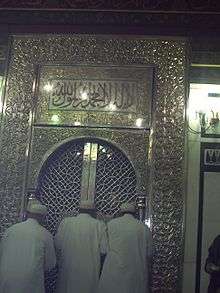 Fatimid Imam era, Cairo, Egypt, 11 to 21st Imam, 881/909 AD-1138 AD
Fatimid Imam era, Cairo, Egypt, 11 to 21st Imam, 881/909 AD-1138 AD Syedna Hatim Rauza, Yemen era 2nd Daur us Satr start with 1st Dai Zoeb, 1138 AD
Syedna Hatim Rauza, Yemen era 2nd Daur us Satr start with 1st Dai Zoeb, 1138 AD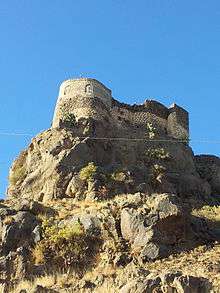 Syedna Idris Court
Syedna Idris Court Syedna Idris Rauza
Syedna Idris Rauza Syedna Ali Rauza
Syedna Ali Rauza- Mausoleum Syedna Yusuf Najmuddin bin Suleman, Tayba, Yemen era end with 24th Dai, 1567AD
- Ujjain, 39 & 40th Dai era, 1738-1780 AD
 Mausoleum Dawoodi Bohra Duwat, Burhanpur,41st dai era 1780-1787 AD
Mausoleum Dawoodi Bohra Duwat, Burhanpur,41st dai era 1780-1787 AD Rauzas of seven Dai al Mutlaq at Surat, Gujarat era 1787-1915
Rauzas of seven Dai al Mutlaq at Surat, Gujarat era 1787-1915- Grave 51st Dai Taher Saifuddin, Mumbai, era 1915-1965 AD- contd.
- Mausoleum of 1 st Wali–ul–Hind:Moulai Abadullah, Khambat, Gujarat,(10-11th Century AD)
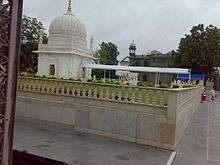 Mausoleum of Moulai Fakhruddin Shaheed, Galiakot, Rajasthan, India(10-11th Century AD)
Mausoleum of Moulai Fakhruddin Shaheed, Galiakot, Rajasthan, India(10-11th Century AD) Dargah of Maula Qazi, Halvad.
Dargah of Maula Qazi, Halvad.
See also
References
- ↑ "Why Bohra Muslims are so enamoured of Narendra Modi".
- ↑ "Society: Why we work".
- 1 2 Jonah., Blank, (2001). Mullahs on the mainframe : Islam and modernity among the Daudi Bohras. Chicago: University of Chicago Press. p. 51. ISBN 0226056767. OCLC 44502485.
- ↑ Administrator. "The Official Website of The Amman Message - grand list of endorsements of the amman message and its three points". ammanmessage.com. Retrieved 2016-03-11.
- ↑ "Mufti Desai of Darul Uloom Abu Bakr in South Africa voicing criticisms of the Amman Message". islamopediaonline.org. Retrieved 2016-03-11.
- 1 2 Mustafa Abdulhussein (27 September 2001). Al-Dai Al-Fatimi, Syedna Mohammed Burhanuddin: an illustrated biography. Al-Jamea-Tus-Saifiyah. ISBN 978-0-9536256-0-4.
- ↑ "The Dawoodi Bohras - Heritage". www.thedawoodibohras.com. Retrieved 2018-04-12.
- ↑ Ghul, Mahmud; Makarem, Sami N. "The Hidden Imams of the Ismailis". Quarterly Journal of the American University of Beirut. XXI. Nos. 1 2. Archived from the original on 28 February 2010.
- ↑ ; Unique case: From Akbar’s court in 1591 to Bombay HC
- ↑ ; History of Duat Mutlakin's of Ahmedabad
- ↑ "Our mission - All is not well with our community". Archived from the original on 25 March 2017. Retrieved 26 March 2017.
- 1 2 3 4 5 Paul, Eva (2006). Die Dawoodi Bohras – eine indische Gemeinschaft in Ostafrika (PDF). Beiträge zur 1. Kölner Afrikawissenschaftlichen Nachwuchstagung.
- ↑ The Ismaili, their history and doctrine by Farhad Daftary. Chapter -Mustalian Ismailism-p.300-310
- ↑ 'Vali-e-Hind Maulai Adam bin Suleman [a.q.] By- Mu. Saifuddin Surka NKD' "Archived copy". Archived from the original on 20 November 2008. Retrieved 8 April 2012.
- 1 2 3 Blank, Jonah (2001). Mullahs on the Mainframe: Islam and Modernity Among the Daudi Bohras. University of Chicago Press. p. 180.
- ↑ ; Record No. 52; Syedna Taher Saifuddin’s RA Testimony in the Chandabhoy Galla Case 1920, pp. 280-284
- ↑ http://www.iis.ac.uk/SiteAssets/pdf/sayyida_hurra%5Bpermanent+dead+link%5D[1].pdf, Sayyida Hurra: The Isma'ili Sulayhid Queen of Yemen, Farhad Daftary, page 7 ,8
- ↑ "IIS".
- ↑ http://www.dnaindia.com/mumbai/report-bombay-high-court-cancels-cross-examination-of-khuzaima-qutbuddin-due-to-his-death-2199109
- ↑ Family tree available at Risalah no.SMS00 His Holiness, Syedna Aali Qadr Mufaddal Saifuddin Saheb. رسالة النعي المسماة - حكمة الغيبة القدسانية الابدية Hikmah al-Ghaybah al-Qudsāniyyah al-Abadiyyah. , Year: |1435H|1436H|2016|-
- ↑ "Syedna Burhanuddin donates over Rs 103cr to provide funding for interest-free loan". The Times of India.
- ↑ Blank, Jonah (2001). Mullahs on the Mainframe: Islam and Modernity among the Daudi Bohras. p. 51. ISBN 0-226-05677-5.
- ↑ Ismāʻı̄lı̄s: Their History and Doctrines - Farhad Daftary - Google Books. Books.google.com. Retrieved 2013-03-09.
- ↑ "12th Rabi ul Awwal, Mawlid and the Hijri-Misri Calendar". The Dawoodi Bohras. Retrieved 2018-04-12.
- ↑ "Tehelka - India's Independent Weekly News Magazine". archive.tehelka.com. Retrieved 2016-03-11.
- ↑ Kumar Suresh Singh; Rajendra Behari Lal; Anthropological Survey of India (2003). Gujarat. Popular Prakashan. pp. 248–. ISBN 978-81-7991-104-4. Retrieved 22 March 2012.
- ↑ Michel Adam (2009). L'Afrique indienne: les minorités d'origine indo-pakistanaise en Afrique orientale. KARTHALA Editions. pp. 272–. ISBN 978-2-8111-0273-9. Retrieved 22 March 2012.
- ↑ Himadri Banerjee (10 July 2009). Calcutta Mosaic: Essays and Interviews on the Minority Communities of Calcutta. Anthem Press. pp. 200–. ISBN 978-81-905835-5-8. Retrieved 22 March 2012.
- ↑ Bhattacharyya, Sourish (30 March 2013). "Faith & food in the Bohra way". Mail Today. New Delhi. Retrieved 6 May 2014.
- ↑ Parmar, Vijaysinh (15 February 2012). "'Community kitchen' gives Bohra women freedom from cooking". The Times of India. Retrieved 6 May 2014.
- 1 2 "From Gurukul to IBO varsity". Times of India. 6 November 2009.
- ↑ Hozefa Mohiyuddin, Tasbeeh al Mafakhir, Neelam Publication, 2012, Section Timeline pg. 24
- ↑ Hellen E. Ulrich, ed. (1975). Competition and Modernization in South Asia. Abhinav Publications. p. 158.
- ↑ "Aligarh Muslim University". amu.ac.in. Retrieved 2016-03-11.
- ↑ "Syedna Mohammed Burhanuddin elected chancellor of Aligarh Muslim University". Retrieved 7 April 2014.
- ↑ "Syedna laid to rest". Business Standard. Retrieved 18 January 2014.
- ↑ "Leadership dispute divides India's Dawoodi Bohra sect". The National. Archived from the original on 25 March 2017. Retrieved 25 March 2017.
- ↑ Hellen E. Ulrich, ed. (1975). Competition and Modernization in South Asia. Abhinav Publications. p. 175.
- ↑ Blank, Jonah (2001). Mullahs on the Mainframe: Islam and Modernity Among the Daudi Bohras. Chicago and London: University of Chicago Press. pp. 125–126.
- 1 2 Raja, Tasneem (21 April 2017). "I Underwent Genital Mutilation as a Child—Right Here in the United States". Mother Jones.
- ↑ Cole, Diana (8 February 2016). "UNICEF Estimate Of Female Genital Mutilation Up By 70 Million", National Public Radio.
- ↑ Blank 2001, p. 57.
- ↑ Chandran, Rina (17 March 2016). "Men join campaigns in India against FGM rituals among the Bohra". Reuters. Karimjee, Mariya (6 May 2016). "Whose Great Idea Was This?". This American Life. Taher, Mariya (February 2017). Understanding Female Genital Cutting in the Dawoodi Bohra Community: An Exploratory Survey. Sayiho, p. 6. Poisson, Jayme; Henry, Michele (21 August 2017). "Women in small Muslim sect say they have had FGM in Canada". Toronto Star.
- 1 2 A2 v R; Magennis v R; Vaziri v R [2018] NSWCCA 174. Court of Criminal Appeal, Supreme Court New South Wales. 10 August 2018. Laurence, Emily (11 August 2018). "Genital mutilation convictions overturned after new evidence showing victims remain intact". ABC News (Australia).
- ↑ Sarkar, Gaurav and Ashar, Hemal (15 April 2017). "Will the Syedna finally denounce khatna now?". mid-day.com.
- ↑ "Female genital mutilation", World Health Organization, 31 January 2018.
- ↑ Al-Awa, Mohamed Selim (2012). "FGM in the Context of Islam", UNFPA, p. 2. Denny, Frederick Mathewson (2001). "Circumcision". In McAuliffe, Jane Dammen. Encyclopaedia of the Qur'an. 1, A-D. Leiden: Brill. pp. 366–367. Rouzi, Abdulrahim A. (2013). "Facts and controversies on female genital mutilation and Islam". The European Journal of Contraception & Reproductive Health Care. Taylor & Francis. 18 (1): 10–14. doi:10.3109/13625187.2012.749982.
- ↑ For example, Ekmeleddin İhsanoğlu, Secretary-General of the Organisation of Islamic Cooperation said in 2012 that "Islam does not support it"; see "Secretary general of Organisation of Islamic Cooperation speaks in Jakarta at conference on the role of women in development". Thomson Reuters Foundation. 4 December 2012.
- ↑ Arora, Kavita Shah; Jacobs, Allan J. (22 February 2016). "Female genital alteration: a compromise solution". Journal of Medical Ethics, 00:1–7. doi:10.1136/medethics-2014-102375
- ↑ Das, Mohua (29 April 2016). "Bohra cleric urges female genital mutilation?". Times of India.
- ↑ "Judge dismisses 1 charge in Michigan female genital mutilation case". The Associated Press, 16 January 2018. Belluck, Pam (10 June 2017). "Michigan Case Adds U.S. Dimension to Debate on Genital Mutilation", The New York Times.
- ↑ Westcott, Lucy (18 April 2017). "'Religious' Claim by Doctor Accused of Female Genital Mutilation". Newsweek.
- ↑ Mullahs on the Mainframe: Islam and Modernity Among the Daudi Bohras; By Jonah Blank
- ↑ "Muharram". 2010-12-08. Retrieved 2010-12-08.
- ↑ "Tanzania: Bohra Leader to Lead Dar Religious Congregation". Retrieved 26 March 2017.
- ↑ "Masjid History". Anjuman-E-Burhani. Archived from the original on 27 January 2008. Retrieved 9 March 2013.
- ↑ malumaat.co Archived 28 August 2006 at the Wayback Machine.
- ↑ malumaat.com Archived 28 September 2007 at the Wayback Machine.
- ↑ "V K Singh lauds Dawoodi Bohra community's role in 'Operation Rahat'". timesofindia-economictimes. Retrieved 2016-03-11.
- ↑ ; Biggest Urban Makeover: How A Mumbai Trust Is Bringing Free Homes For 20,000
- ↑ ; Mumbai’s bustling Bhendi bazaar is set for a makeover
- ↑ ;what-ails-the-bhendi-bazaar-project
- ↑ "SBUT".
- ↑ The year of the Attack of the army with While Elephants on Makkah which was led by Yemeni Commander Abrahah who came to destroy Ka'bah
- ↑ It is the supreme authoritative position during Fatimid Caliphate where he enjoyed the status of Chief Missionary and Chief Justice under the direct commands of an Imam
- ↑ A unit of prayer-namaaz which consists of standing, one time bowing and two times prostrating
- 1 2 It is Naafelat (Voluntary) prayer offered after Maghrib and 'Ishaa il-Aakherat Namaaz. It has multiple Rak'aat and one who prays it is supposed to have prayed for the whole night. Technically, during such meritorious nights, a faithful must pray for the whole night, but this designated Naafelat prayer amounts to the Reward of the prayer of Whole Night.
- ↑ The Taiyebi spiritual mission led by the 1st Da'i Saiyedna Zo'eb in Yemen under the hidden guidance of Imam us Satr, the Imam under Occultation 21st Imam at-Taiyeb and his progeny.
- ↑ After farz and sunnat namaaz, this type of prayer is offered voluntarily and it is up to the believer how many rak'at he intends to offer
- 1 2 Intercession and Intermediary person from Da'wah Shareefah with special status who is granted permission and has spiritual powers to pardon mistakes of Believers and invites reward for good deeds from Allaah Ta'aala
- ↑ Baab is the Shi'a-Isma'ili term used for the immediate person who is of high spiritual status after Muhammad or the Imam from his progeny. Baab ul Abwaab means the Door of the Doors, that leads to the Zenith of Spiritual Hierarchy i.e. Imam. Maulaa 'Ali is the Baab of Mohammad
- ↑ Maa'edah is a term used specially in Alavi & Dawoodi Bohras customary social events when followers get together and sit around a big platter in a group of 7 on the floor and eat from a single plate. Each item they eat or drink together with strict discipline and in the last the food left in the plate is equally distributed among a group
Further reading
- The Dawoodi Bohras: an anthropological perspective, by Shibani Roy. Published by B.R. Publishing, 1984.
- Bin Hasan, Idris, Uyun al-akhbar (Bin Hasan was the 19th Da'i of the Dawoodi Bohra. This volume is a history of the Ismaili community from its origins up to the 12th century CE., the period of the Fatimid caliphs al-Mustansir (d. 487/1094), the time of Musta‘lian rulers including al-Musta‘li (d. 495/1101) and al-Amir (d. 524/1130), and then the Tayyibi Ismaili community in Yemen.)
- A Short History of the Ismailis, By Farhad Daftary
- The Ismaili, their history & Doctrine, By Farhad Daftary
- Medieval Islamic Civilisation, By Joseph W. Meri, Jere l.Bacharach
- Sayyida Hurra: The Isma‘ili Sulayhid Queen of Yemen, By Dr Farhad Daftary
- Cosmology and authority in medieval Ismailism, By Simonetta Calderini
- Religion, learning, and science in the ʻAbbasid period, By M. J. L. Young, John Derek Latham, Robert Bertram Serjeant
External links
![]()